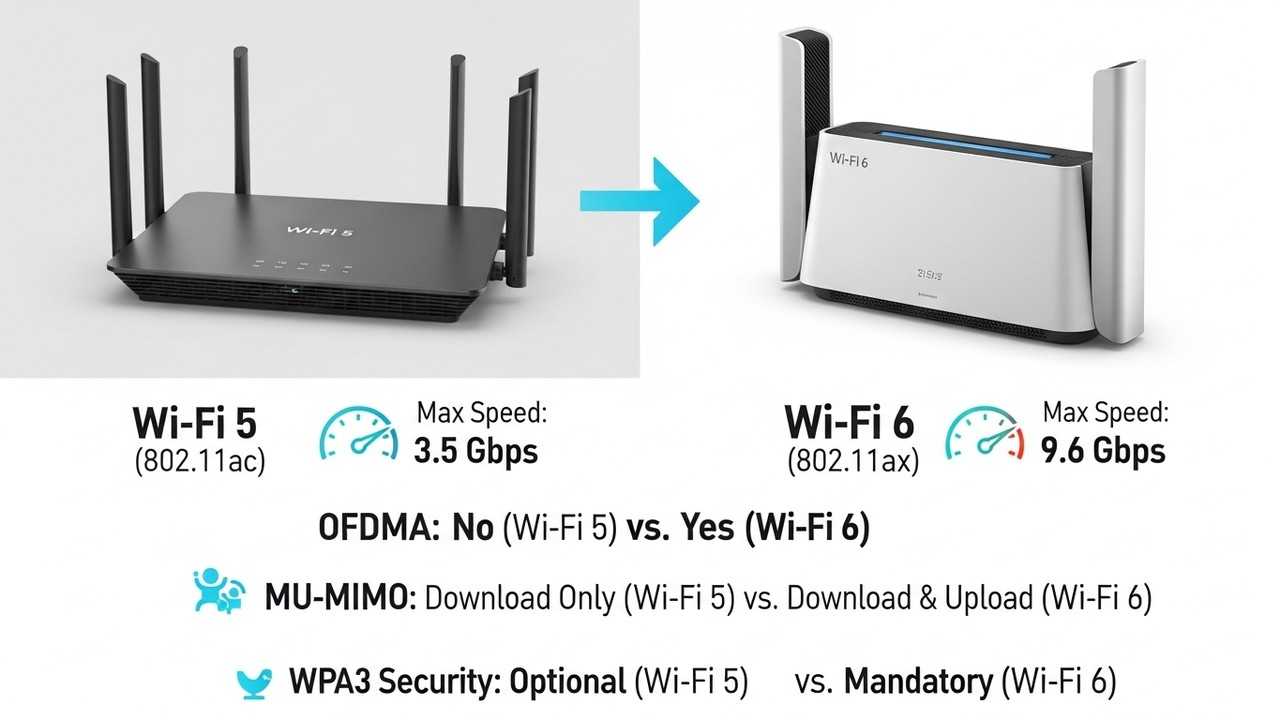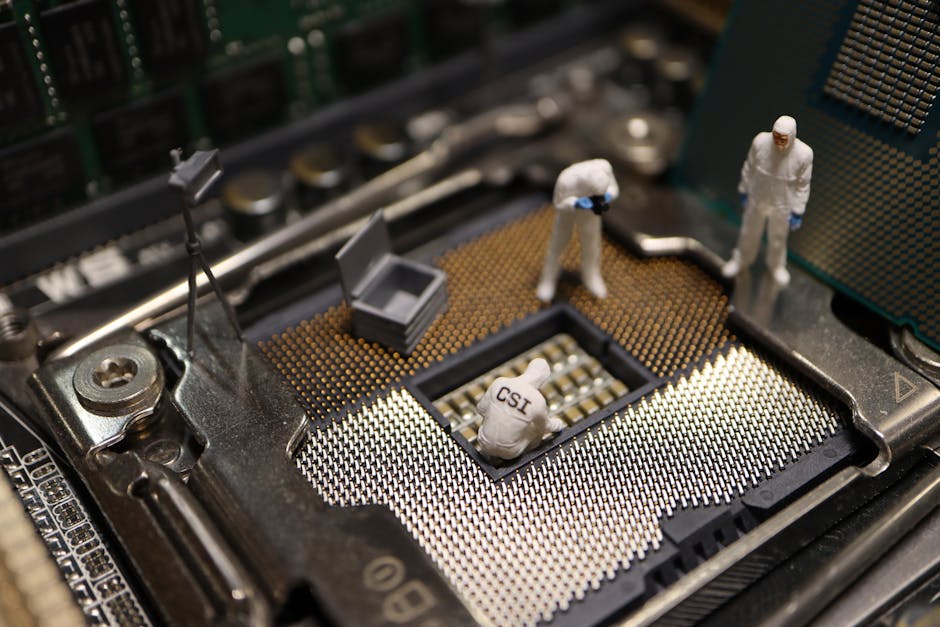Let’s delve into the world of wireless connectivity and explore the evolution of Wi-Fi. Wi-Fi 6, the newest standard, promises significant improvements over its predecessor, Wi-Fi 5. This article examines the key differences and advantages that Wi-Fi 6 offers, providing a clear understanding of what makes it a superior choice for your home or office network. Understanding these advancements is crucial in today’s tech-driven world.
Table of Contents
Read More
Wi-Fi 6, the latest iteration of wireless networking technology, represents a significant leap forward from its predecessors. Understanding its capabilities and improvements over earlier standards like Wi-Fi 5 is crucial for anyone looking to optimize their home or office network. The evolution of Wi-Fi is a story of continuous innovation, driven by the ever-increasing demands of modern digital life. This article delves into the core features of Wi-Fi 6, contrasting them with Wi-Fi 5 to highlight the advancements and benefits that make it a superior choice for today’s connectivity needs.
Wi-Fi 6: A New Era in Wireless Connectivity
Wi-Fi 6, also known as 802.11ax, is designed to address the growing needs of modern wireless networks. The evolution from Wi-Fi 5, or 802.11ac, brings substantial improvements in speed, efficiency, and capacity. These enhancements are particularly noticeable in environments with numerous connected devices, such as smart homes, offices, and public spaces. In an age where the number of connected devices per household is skyrocketing, Wi-Fi 6 offers the performance needed to maintain seamless connectivity for everyone.
Key Features of Wi-Fi 6
Wi-Fi 6 introduces several key technologies to enhance performance. One of the most significant is Orthogonal Frequency-Division Multiple Access (OFDMA), which improves efficiency by allowing multiple devices to share a channel simultaneously. This contrasts with Wi-Fi 5, where each device had to wait its turn. Another critical feature is Multi-User Multiple Input Multiple Output (MU-MIMO), which allows access points to communicate with multiple devices at once, increasing overall network capacity. Finally, Wi-Fi 6 supports a wider channel width, which allows for higher throughput and faster data transfer rates. These improvements collectively make Wi-Fi 6 a more efficient and robust standard.
The Benefits of OFDMA
OFDMA is a game-changer for Wi-Fi 6. It divides each channel into smaller sub-channels, allowing an access point to serve multiple devices concurrently. This approach significantly reduces latency and improves network efficiency, especially in crowded environments. For example, in a busy office setting, OFDMA ensures that each user receives a fair share of bandwidth, preventing any single device from monopolizing the network. Compared to Wi-Fi 5, OFDMA’s ability to handle multiple devices simultaneously is a major advantage, contributing to a more responsive and reliable user experience.
Wi-Fi 5 vs. Wi-Fi 6: A Comparative Analysis
Wi-Fi 5, or 802.11ac, was a significant upgrade from its predecessors, offering faster speeds and improved performance. However, Wi-Fi 6 builds upon these improvements with several key advancements. The primary differences between Wi-Fi 5 and Wi-Fi 6 lie in their technological underpinnings and performance capabilities. While Wi-Fi 5 provided a solid foundation, Wi-Fi 6 takes wireless networking to the next level, especially in environments with numerous connected devices.
Speed and Throughput
Wi-Fi 6 offers a significant increase in speed and throughput compared to Wi-Fi 5. While Wi-Fi 5 offered theoretical speeds of up to 3.5 Gbps, Wi-Fi 6 can achieve up to 9.6 Gbps. This increase is due to several factors, including wider channel widths and more efficient data encoding. In practical terms, this translates to faster downloads, smoother streaming, and improved overall network performance. For instance, downloading large files or streaming 4K video is noticeably quicker on a Wi-Fi 6 network compared to a Wi-Fi 5 network. The speed advantage makes Wi-Fi 6 ideal for bandwidth-intensive applications.
Efficiency and Capacity
Wi-Fi 6 is designed to be more efficient and capable of handling a higher number of connected devices. This is largely due to the introduction of OFDMA and MU-MIMO technologies, which allow access points to communicate with multiple devices simultaneously. In contrast, Wi-Fi 5 relies primarily on single-user MIMO, which limits the number of devices that can communicate at the same time. The improved efficiency and capacity of Wi-Fi 6 make it an excellent choice for homes with many smart devices or offices with numerous connected computers and devices.
Practical Implications and Real-World Scenarios
The advancements in Wi-Fi 6 have significant practical implications for everyday users. From faster downloads to improved performance in crowded environments, the benefits are clear. Upgrading to Wi-Fi 6 can dramatically improve the user experience, whether for streaming movies, video conferencing, or online gaming. These improvements are particularly valuable in today’s connected world, where multiple devices are often used simultaneously. This section explores how these advancements translate into real-world benefits.
Home Network Enhancements
In a typical home setting, Wi-Fi 6 can significantly enhance the user experience. With multiple devices such as smartphones, tablets, smart TVs, and gaming consoles connected simultaneously, the network can become congested. Wi-Fi 6’s ability to handle multiple devices efficiently ensures that each device receives sufficient bandwidth. This results in smoother streaming, faster downloads, and a more responsive experience overall. For instance, a family watching 4K movies on multiple devices while someone else is gaming online will experience minimal lag or buffering on a Wi-Fi 6 network.
Business and Office Applications
In business environments, Wi-Fi 6 offers several advantages, especially in offices with numerous connected devices. The increased capacity and efficiency of Wi-Fi 6 help to prevent network congestion, ensuring that employees can work without interruption. This is particularly important for tasks that require high bandwidth, such as video conferencing, large file transfers, and cloud-based applications. The improved performance of Wi-Fi 6 contributes to increased productivity and a more reliable network infrastructure. In a busy office environment, Wi-Fi 6 can handle numerous devices simultaneously, providing a seamless and reliable network experience for everyone.
Key Takeaways
Wi-Fi 6 represents a significant advancement over Wi-Fi 5, offering improved speed, efficiency, and capacity. Key technologies such as OFDMA and MU-MIMO enable Wi-Fi 6 to handle multiple devices more efficiently and provide a better user experience. From home networks to business applications, Wi-Fi 6 provides a superior wireless experience. As technology continues to evolve, Wi-Fi 6 is well-positioned to meet the demands of modern wireless connectivity, ensuring that users can enjoy seamless and reliable internet access.
| Feature | Wi-Fi 5 (802.11ac) | Wi-Fi 6 (802.11ax) |
|---|---|---|
| Maximum Speed | 3.5 Gbps | 9.6 Gbps |
| Efficiency | Less Efficient | More Efficient (OFDMA, MU-MIMO) |
| Channel Width | 80 MHz, 160 MHz | 160 MHz |
| Multi-User Capability | MU-MIMO (limited) | MU-MIMO (improved) |
| Best Use | Home and Office | Home, Office, High-Density Environments |
We also Published
RESOURCES
- Is wifi 6 worth it over wifi 5? : r/HomeNetworking
- 5 Reasons You Should Consider Upgrading to a WiFi 6 Router …
- Is wi-fi 6 worth it over wi-fi 5? : r/HomeNetworking
- Wi-Fi 5 vs. Wi-Fi 6: 10 Key Differences – Spiceworks
- Convince me why I need Wi-Fi 6 or even 7 : r/HomeNetworking
- Wi-Fi 6 vs. Wi-Fi 5: What’s the difference? | TechTarget
- WiFi 6 vs WiFi 5: 6 Proven Benefits With 3X Faster Speeds for Smart …
- mixing WiFi-5-and-earlier vs WiFi-6-and-later APs on a network …
- Demystifying Wi-Fi: A Comprehensive Comparison of Wi-Fi 5, 6, and 7
- WiFi 5 vs. WiFi 6: What’s the Difference? | TP-Link Baltic








0 Comments